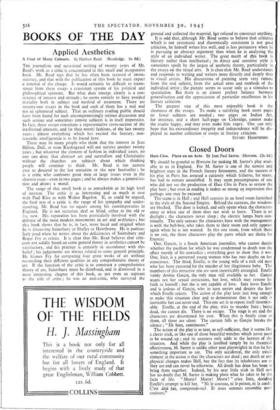BOOKS OF THE DAY
Applied Aesthetics
A Coat of Many Colours. By Herbert Read. (Routledge. 8s. 6d.)
THE journalism and occasional writing of twenty years of Mr. Read's work as a critic is concentrated in this small and inexpensive book. Mr. Read says that he has often been accused of incon- sistency, and that with the publication of this book he must expect a renewal of the charge. It wouid certainly be difficult to recon- struct ftom these essays a consistent system of his political and philosophical opinions. But what does emerge clearly is a con- sistency of interest and attitude ; he seems entirely to have avoided triviality both in subject and method of treatment. There are seventy-one essays in the book and each of them has a real and not an ephemeral subject. That an ordinary reading public should have been found for such uncompromisingly serious discussion and such serious and sometimes remote subjects is in itself impressive. In fact, these essays constitute a representative cross-section of the intellectual interests, and (at their worst) fashions, of the last twenty years ; almost everything which has excited the literary, non- scientific intelligentsia is to be found here.
There may be many people who think that the interest in Jean Dali, or even Kierkegaard will not survive another twenty years ; but whatever the element of fashion in individual cases, no one con deny that abstract art and surrealism and Christianity without the churches are subjects about which thinking people will continue to think. Mr. Read is too austere ever to descend to the last sensation or the new bese.seller ; he is a critic who confronts great men or large issues even in the shortest essay—even in two pages ; and he always makes a generalisa- tion and draws a moral.
The range of this small book is as remarkable as its high level of interest. The critic is as interesting and as much at ease with Paul Klee as with Walter Bagehot. If, as could be argued, the final test of a critic is the range of his sympathy and under- standing, Mr. Read has no equals among his contemporaries in England. He is not sectarian, deaf or blind, either to the old or ?ite new. His reputation has been particularly involved with the defence of the most modern movements in art and aesthetics ; but this book shows that he is, in fact, more lucid and original when he is 'discussing Saintsbury or Shelley or Hawthorne. He is particu- larly good when he writes about the deficiencies of Sairitsbury and Roger Fry as critics. It is clear that 'Mr. Read believes that criti- cism not solidly based on some general theory in aesthetics cannot be satisfactory, and Ibis practice is certainly in accordance with this belief ; his judgements are always related to some general principle. He blames Fry for comparing four great works of art without reconciling their different qualities in any comprehensive theory of art. If the function of the critic is to construct a comprehensive theory of art, .Saintsbury must be dismissed, and is dismissed in a most interesting chapter of this book, as not even an aspirant to the title of critic ; he was an anti-critic, who surveyed the ground and collected the material, hut refused to construct anything.
. It is odd that, although Mr. Read seems to believe thak criticism which is not systematic ar.d theoretically consistent is not good criticism, he himself writes less well, and is less persuasive when he is pursuing an abstract argument than when he is analysing the style of an individual writer. The great merit of this book is literary rather than intellectual' its direct land sensitive style is sometimes spoilt by the jargon of aesthetic theory, particularly in the essays on the visual arts. It is clear that Mr. Read understands and responds to writing and writers more directly and deeply than to visual artists. His discussions of ;painting seem very remote from the real subject, from the actual aims and methods of the individual artist ; the picture seems to occur only as a stimulus to speculation. But there is an almost perfect balance between generalisation and the appreciation of particular excellences in his literary criticism.
The greatest vice of this most enjoyable book is the shortness of the essays. To make a satisfying book more pages on fewer subjects are needed ; two pages on Indian Art, for instance, and a short half-page on Coleridge, cannot make the reader happy, and may even make him angry. One can only hope that his extraordinary integrity and independence will be dis- played in another collection of essays in literary criticism.
STUART HAMPSHIRE.






























 Previous page
Previous page